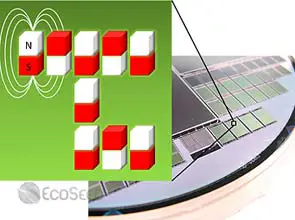Two researchers at the University of California, Berkeley, Jeffrey Bokor and Brian Lambson are developing a new concept called “Magnetic Microprocessors”. According to them, this new concept would be so efficient that the energy consumed by them will be very less as described by the 2nd law of thermodynamics. Though the multi-processors used today are known to be efficient, the fact is that the energy consumed by them is fairly high when compared to its speed and multi-tasking capability.
As the name implies, the magnetic microprocessor will work on the principle of magnetic properties, and without the use of electrons. The microprocessors used now work on the principle of electricity, which means that they produce the energy required, by the movement of electrons. This movement of electrons generate heat and thus reduces the efficiency of the system. Since, magnetic microprocessors work without electrons, the researcher’s claim that the device would be a million times more efficient than the conventional processors used today.
In this device, the digital memory (combination of 0′s and 1′s) is represented with the help of nano-magnet polarities. The size of these magnets will be very small and millions of them will be kept close together so that their poles will interact and create the basic logic operations, similar to the transistors used now
As the name implies, the magnetic microprocessor will work on the principle of magnetic properties, and without the use of electrons. The microprocessors used now work on the principle of electricity, which means that they produce the energy required, by the movement of electrons. This movement of electrons generate heat and thus reduces the efficiency of the system. Since, magnetic microprocessors work without electrons, the researcher’s claim that the device would be a million times more efficient than the conventional processors used today.
In this device, the digital memory (combination of 0′s and 1′s) is represented with the help of nano-magnet polarities. The size of these magnets will be very small and millions of them will be kept close together so that their poles will interact and create the basic logic operations, similar to the transistors used now
A diagram showing the interaction between the North and South Pole is given below.
Theoretically, during a basic AND or OR logical operation, the minimum energy loss that a device produces `at normal temperature is supposed to be 18 millielectron volts. This loss limit is known as Landauer limit and was proposed by Rolf Landauer 50 years ago. The researchers are trying to bring this theory into practise with the help of magnetic microprocessors. If they succeed in bringing this theory into practise, it would mean that the energy dissipated by the device is lesser than the thermal energy of atoms at normal temperature!!
They also claim that since the Landauer limit is proportional to temperature, the use of such a device at cold conditions would further increase its efficiency.
According to Jeffrey Bokor, the device would turn out to be revolutionary, even if the efficiency would be within a factor of 10 of the Landauer limit. They came to the conclusion that they could reach Landauer limit after conducting a simple memory operation with a magnetic logic circuit. The experiment was to erase a magnetic bit and the energy lost to conduct the test was very close to Landauer limit.
The problem with such a device is that, somehow electricity is needed for the generation of a magnetic field. This will clearly lessen the efficiency to a great extent. But, the researchers believe that in future, materials like multiferroic alloys could make the electrical currents unnecessary. Thus, the electronics world would be clearly dominated by magnetonics.
They also claim that since the Landauer limit is proportional to temperature, the use of such a device at cold conditions would further increase its efficiency.
According to Jeffrey Bokor, the device would turn out to be revolutionary, even if the efficiency would be within a factor of 10 of the Landauer limit. They came to the conclusion that they could reach Landauer limit after conducting a simple memory operation with a magnetic logic circuit. The experiment was to erase a magnetic bit and the energy lost to conduct the test was very close to Landauer limit.
The problem with such a device is that, somehow electricity is needed for the generation of a magnetic field. This will clearly lessen the efficiency to a great extent. But, the researchers believe that in future, materials like multiferroic alloys could make the electrical currents unnecessary. Thus, the electronics world would be clearly dominated by magnetonics.
There may be doubts as to whether if such a device is replaced with the microprocessor used now and then made to work with a conventional computer, will there be any problems? The answer is not at all. Though there will be magnetic effects around the device, it will not be strong enough to wipe out the contents of the hard drive. The magnetic fields produced will be very small and thus have smaller strength. They would only work, and interact with each other, because of the inverse relationship between field intensity and distance. At a billionth of a meter such fields would interact with each other, but however strong they are then would weaken by more than a billion fold when they are very near.
Actually, the problem may occur the other way around. The conventional hard drive could easily overpower any of these that were too close
Actually, the problem may occur the other way around. The conventional hard drive could easily overpower any of these that were too close
Share this on your favourite network








0 comments:
Post a Comment